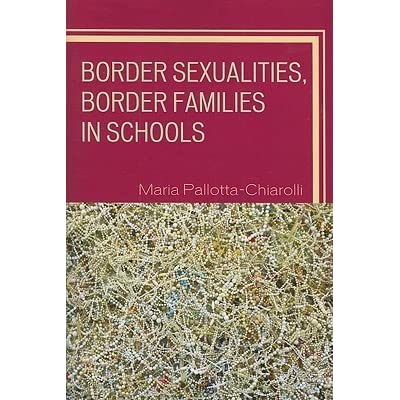Reviewed by Lisa Keele
Border Sexualities, Border Families in Schools is a timely publication, given the recent press attention given to teenage suicides as a direct result of homophobic bullying—mistreatment by their peers relating to perceived or actual sexual orientation. No doubt some school administrators are wondering what they can do to help create a safe school environment for all of their children. Indeed, there is much that schools can do to help eliminate bullying and to support children who themselves identify as non-heterosexual, or who come from homes with non-heterosexual parents.
This book argues that even in schools where such diversity is acknowledged and policies are created to foster the best learning environment for all, students are sorted into the “straight” filing cabinet or the “gay” filing cabinet, by virtue of their own orientation or that of their family members. Missing from much of the discussion is the border group: students who identify as something other than heterosexual or homosexual, and students who come from family structures where parents are bisexual, of mixed sexual orientations, and/or in polyamorous or multi-partner relationships. Such students often feel invisible or overlooked even in such diversity-friendly environments. The authors of this book call these students “the X-files”; their file belongs neither in the “heterosexual” nor the “homosexual” filing cabinets. This book examines the school experience of these borderland children, and makes specific recommendations for the best ways to include them.
The book is a first of its kind, and as such, takes great pains to do background work and to share first-hand experience by students and their parents. Thus, the first chapter, “Messing Up the School Sex Filing Cabinet,” defines terms such as bisexual, multisexual, polyamorous, queerly mixed families, etc., and summarizes research on borderland students and their families. Chapter 2 is almost entirely theoretical in nature. It delves into detail on the flavors of polyamory, for example, and discusses how varying definitions can affect research. It examines the nature of human dichotomies and various ways in which humans can break these dichotomies, “messing up” the filing cabinets created by society to easily categorize something that is in fact complex. Chapters 3 and 4 examine the experience of borderland children in schools, and present overviews on the available literature, as well as the author’s own empirical research, with Chapter 3 dedicated to bisexuality of the student Book Review: Border Sexualities, Border Families in School by Maria Pallotta-Chiarolli Reviewed by Lisa Keele and/or their parent(s), and Chapter 4 dedicated to polyamorous, multipartnered, or multisexual families. Chapter 5 summarizes the findings of the author’s research and calls for schools “to move from models of difference and dichotomy to models of diversity and multiplicity” (27).
Concrete recommendations to schools include: incorporating books and visual resources about bisexuality and polyamory; incorporating bisexual or polyamorous historical figures into the curriculum; explicitly including bisexual and polyamorous discussions/speakers during Diversity Awareness Week; professional development for staff on X-files issues; and effective anti-harassment and anti-discrimination policies and staff training.
The best part of this book is the inclusion of many quotations from students interviewed, who speak candidly, sometimes harrowingly, and often charmingly about their own experiences. A couple of my favorites are from seventeen-year-old Marita: “I’m an anonymous random. I like being a random, but it’s being anonymous that’s crap” (221), and fifteen-year-old Wendy: “The world isn’t heterosexual or homosexual, it’s lotsasexuals” (3). Seventeen-year old Linda underlines the need for just such research to be done, when she writes: “I got thrown downstairs, punched and threatened with rape by boys for coming out as bi. They said raping me would take away the lesbian parts. I’d tried several times to complain to the principal. I reported what these guys were doing, but all he said all the time was that since I’d done this foolish thing and come out, he could guarantee no protection; I’d brought it on myself” (99-100).
This book is not one I would recommend directly to educators; it is fairly dense and theoretical, heavy on the research and relatively light on concrete recommendations. I can imagine a high school math teacher, worried about the bullying of a bisexual student in her class, encountering a sentence like, “Ironically, my very constructions of ‘border family’ and ‘border sexuality’ are a reflection of hierarchical dualisms and models of difference and dichotomy that uphold the Center and perpetuate panopticonic fear and regulation for those in the Margins” (222). However, educators are not the main audience here; queer theorists are. If one wished to write a book, or a training curriculum, which could help that high school math teacher, and her principal, and the school board in her district (and I dearly hope that someone does), and one wished to write it in such a way as to respect and celebrate true diversity, grounded in theory and understanding of the experiences of those who live their lives in this borderland area between dichotomy, this would be thorough and very useful starting point for just such a project.
Border Sexualities, Border Families in School by Maria Pallotta-Chiarolli was published in 2010 by Rowman & Littlefield Publishers, Inc., Australia.
Lisa was born in Utah, and has seen much of the world, but not quite enough of it yet. Somewhere along the way she managed to pick up her PhD in philosophy, and raise three outstanding sons.

